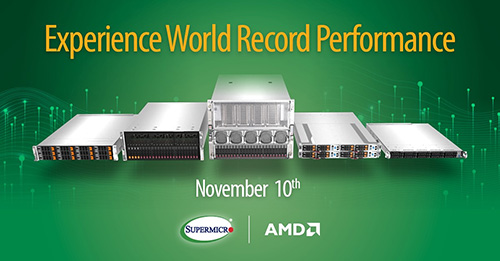HPC Articles
Manage Your HPC Resources with Supermicro's SuperCloud Composer
- November 18, 2022
- Author: David Strom
Today’s data center has numerous challenges: provisioning hardware and cloud workloads, balancing the needs of performance-intensive applications across compute, storage and network resources, and having a consistent monitoring and analytics framework to feed intelligent systems management.
Supermicro Debuts New H13 Server Solutions Using AMD’s 4th-Gen EPYC™ CPUs
- November 16, 2022
- Author: David Strom
Last week, Supermicro announced its new H13 A+ server solutions, featuring the latest fourth-generation AMD EPYC™ processors.
AMD Announces Fourth-Generation EPYC™ CPUs with the 9004 Series Processors
- November 11, 2022
- Author: David Strom
AMD announces its fourth-generation EPYC™ CPUs. The new EPYC 9004 Series processors demonstrate advances in hybrid, multi-die architecture by decoupling core and I/O processes. Part 1 of 4.
Register to Watch Supermicro's Sweeping A+ Launch Event on Nov. 10
Join Supermicro online Nov. 10th to watch the unveiling of the company’s new A+ systems -- featuring next-generation AMD EPYC™ processors. They can't tell us any more right now. But you can register for a link to the event by scrolling down and signing-up on this page.
The Perfect Combination: The Weka Next-Gen File System, Supermicro A+ Servers and AMD EPYC™ CPUs
- October 20, 2022
- Author: David Strom
Weka’s file system, WekaFS, unifies your entire data lake into a shared global namespace where you can more easily access and manage trillions of files stored in multiple locations from one directory.
Eliovp Increases Blockchain-Based App Performance with Supermicro Servers
- October 13, 2022
- Author: David Strom
Eliovp, which brings together computing and storage solutions for blockchain workloads, rewrote its code to take full advantage of AMD’s Instinct™ MI100 and MI250 GPUs. As a result, Eliovp’s blockchain calculations run up to 35% faster than what it saw on previous generations of its servers.
Microsoft Azure’s More Capable Compute Instances Take Advantage of the Latest AMD EPYC™ Processors
- October 11, 2022
- Author: David Strom
Azure HBv3 series virtual machines (VMs) are optimized for HPC applications, such as fluid dynamics, explicit and implicit finite element analysis, weather modeling, seismic processing, and various simulation tasks. HBv3 VMs feature up to 120 Third-Generation AMD EPYC™ 7v73X-series CPU cores with more than 450 GB of RAM.
Supermicro and Qumulo Deliver High-Performance File Data Management Solution
- October 3, 2022
- Author: David Strom
- ‹ previous
- 6 of 7
- next ›












